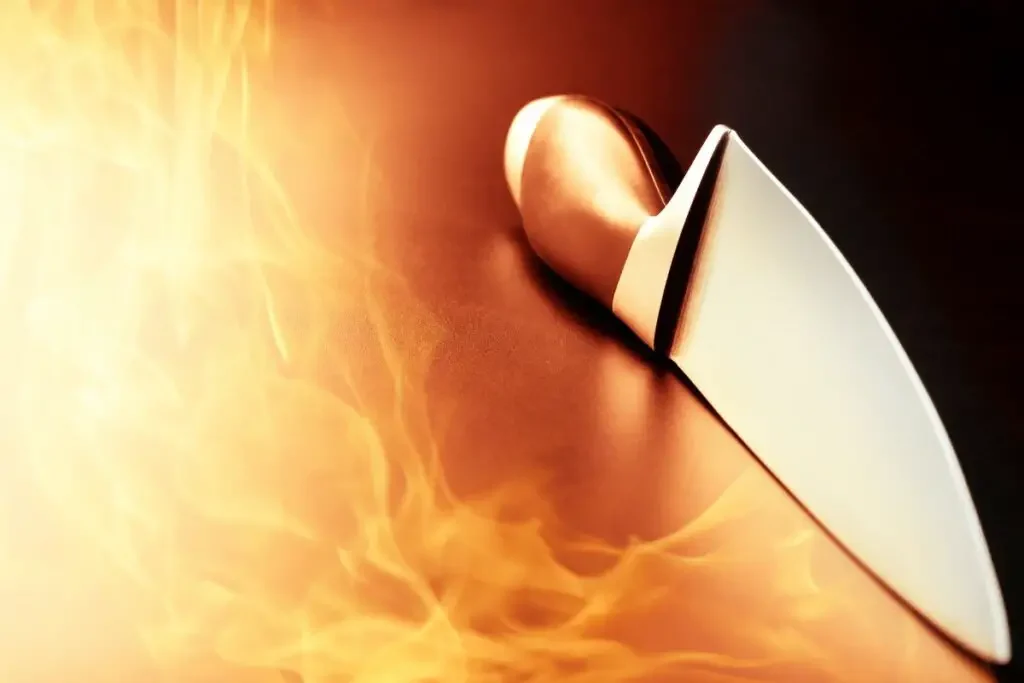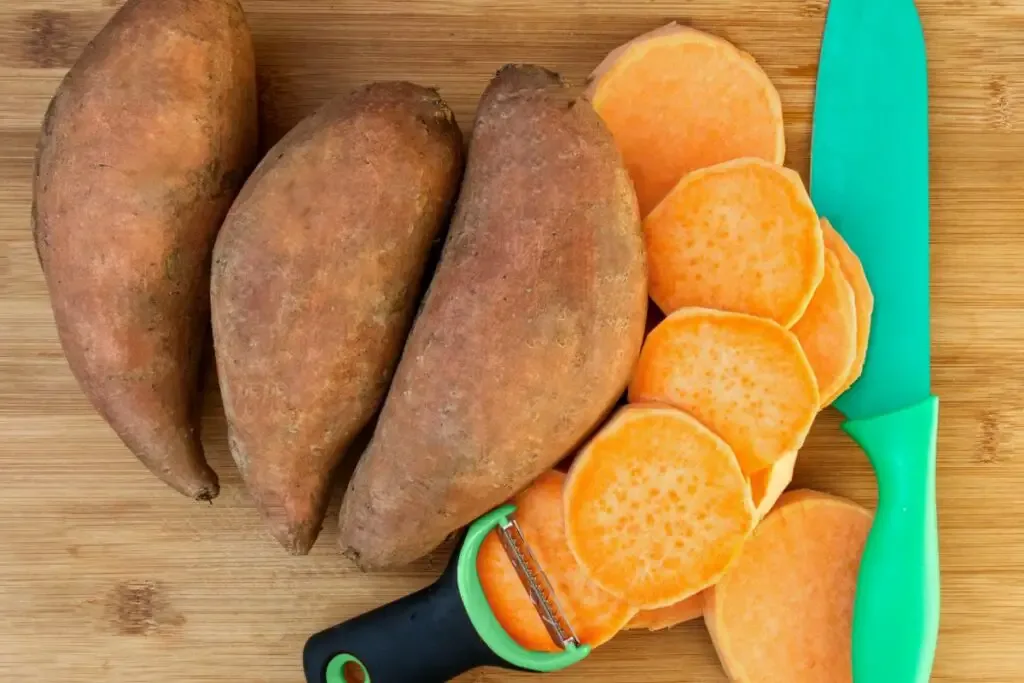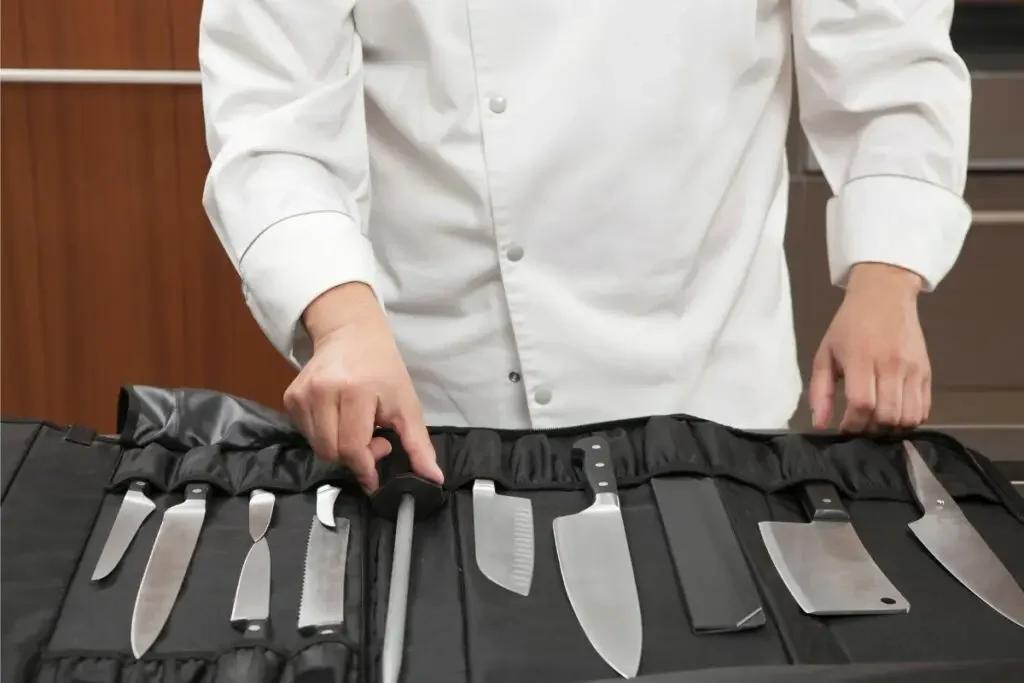As an Amazon Associate, we earn from qualifying purchases with no additional costs for you.
Knives are essential tools in everyday life, and their sharpness is key to their functionality. You may have come across advertisements or claims that certain knives never need sharpening, a promise that seems almost too good to be true. You may also find certain knives do not sharpen well. This prompts the question of whether some knives cannot be sharpened.
All knives can be sharpened, but some knives are more difficult to sharpen than others. Cheap knives made from poor-quality steel may be difficult to sharpen and will not hold an edge for long. Certain knife blade materials are difficult to sharpen due to the hardness or durability of the material.
Some knife manufacturers claim their knives never need sharpening, while you may find difficulty trying to sharpen certain knives. We’ll examine the materials, designs, and technologies that contribute to a knife’s sharpness and whether they can indeed remain sharp for a lifetime. We will also find out if some knives simply cannot be sharpened and why.
If you would like to try a knife that requires less frequent sharpening, we can recommend a Kyocera ceramic Santoku. You can find the link to this recommended knife here. (Amazon Link)
Can All Knives Be Sharpened?

Is there any truth to the claims that some knives can never truly be sharpened, or is this a knife-related urban legend? There is often a good deal of hype around this topic, and we will bring some clarity and truth as we explore whether all knives can be sharpened.
Every knife must have a sharp edge to be useful for its designed purpose unless you are talking about a butter knife, which does not require a sharp edge to fulfill its function.
Knives will come with a factory edge on the blade due to the knife being sharpened before it left its place of manufacture. How well the knife will retain this edge will depend on the edge geometry and the steel quality used to manufacture the blade.
Steel Quality Can Result In Knife Sharpening Issues
The quality of steel used in a knife’s blade is a critical factor that directly impacts its sharpening ability. Not all steels are suitable for knifemaking, and the differences in quality can lead to various sharpening issues.
The Type Of Steel Can Affect Sharpening Effectiveness
The type and quality of the steel used to make a knife blade are key factors in how well the knife will hold an edge and whether it can be sharpened effectively.
- High-Carbon Steel. High-carbon steel is known for its hardness and ability to hold an edge, which is why it is often the steel of choice for quality knife blades. However, it can be more challenging to sharpen if not done correctly.
- Stainless Steel. While resistant to rust and staining, some stainless steel knives may be softer and lose their edge more quickly, requiring frequent sharpening.
- Alloy Steel. Certain alloy steels with added elements like vanadium or molybdenum can offer a balance between hardness and toughness but may require specialized sharpening techniques.
- Cheap Steel. Cheap steel will have less carbon and softer alloys incorporated into the steel to reduce the overall cost of the knife. These knives will dull very quickly, and it will be difficult, if not impossible, to sharpen these knives to a desirable level of sharpness.
TIP: Sharpening a hollow edge knife can be a challenging undertaking for someone new to knife sharpening due to the grind on the knife. Find out how to tackle this sharpening task in our article on the topic!
How To Sharpen A Hollow Edge Knife In 5 Steps
Heat Treatment Can Affect Knife Sharpening

Heat treatment is a process that changes the steel’s structure, affecting its hardness and flexibility. Poorly heat-treated steel can result in a blade that’s either too hard and brittle or too soft and unable to hold an edge.
Cheap knives may have received inadequate heat treatment at the factory. Once these knives have lost their factory edge and become dull, they may not be worth the effort to re-sharpen. If you do attempt to sharpen these knives, you may experience obtaining a sharp edge due to the inferior heat treatment resulting in a steel that is too soft.
TIP: If you are interested in buying a Japanese knife, we recommend these knives (Amazon links):
- Santoku: Yoshihiro NSW Hammered Damascus Santoku
- Gyuto: Yoshihiro VG-10 Hammered Damascus Gyuto
- Nakiri: Yoshihiro Hammered Damascus Nakiri
Steel Grain Structure Can Affect Knife Sharpening
The grain structure of the steel refers to the arrangement of its microscopic components. A fine grain structure usually leads to a sharper edge, while coarse grain can make sharpening more difficult and result in a less durable edge.
The grain structure is usually directly proportional to the steel quality used to make the knife. Poor quality steel results in a coarse grain structure after heat treatment, while quality steel has a fine texture that holds an edge better and responds more favorably to manual sharpening.
Steel Impurities And Inclusions Affect Knife Sharpening
Low-quality steel may contain impurities and inclusions that create weak spots in the blade. These inconsistencies can cause chipping and uneven wear, complicating the sharpening process.
Sharpening Technique Can Affect Sharpening Effectiveness
Different steel qualities may require specific sharpening techniques and tools. Using the wrong method can lead to ineffective sharpening or even damage to the blade.
Steel quality in a knife’s blade is more than just a matter of aesthetics or price; it’s a complex factor influencing how a knife performs, wears, and sharpens. Understanding the type of steel and its characteristics can help you select the right knife for your needs and maintain it properly.
TIP: Getting your knives professionally sharpened periodically can benefit the blade longevity and restore the edge on your knife. Find out why you should consider a professional sharpening for your knife in our article below:
Get Your Knives Sharpened Professionally: Why, Costs & How Often
The Myth of “Never-Need-Sharpening” Knives

The marketing ploy of a knife that never needs sharpening is powerful because many people are not skilled in knife sharpening and consider it a chore. Imagine a knife that remains perpetually sharp, ready to slice through anything with ease, and never requiring the attention of a sharpening stone or honing rod. Wouldn’t you be tempted to purchase such a knife?
This idea has led to the creation and marketing of various knives that claim to be maintenance-free. But how true are these claims? Let’s explore the myth of “never-need-sharpening” knives.
- The Promise. Many manufacturers promote knives with special coatings, serrated edges, or unique materials as never needing sharpening.
- The Reality. While some of these knives may stay sharp longer than traditional blades, they will eventually dull with use. The claim of never needing sharpening is often an exaggeration.
The knives most commonly marketed as “never-need-sharpening” knives are as follows.
- Serrated Knives. Their jagged edges can cut even when dull, but they do eventually wear down.
- Ceramic Knives. Extremely hard but can chip easily, requiring specialized sharpening.
- Metallic Coated Knives. Coatings like tungsten carbide may keep the blade sharp initially but can chip off and become jagged.
The myth of “never-need-sharpening” knives is a compelling marketing narrative that doesn’t hold up under scrutiny. While certain designs and materials may extend the life of a knife’s sharp edge, no knife is truly immune to dulling.
Understanding the nature of different knives and their sharpening needs is essential for anyone looking to invest in quality knives. Rather than seeking a knife that never needs attention, a more practical approach is to learn about proper knife care and sharpening techniques to keep any blade performing at its best.
TIP: Find out my TOP 3 picks of pocket knives if you are interested in buying a pocket knife (Amazon link):
- Victorinox Swiss Army Rangergrip knife: Our favorite feature is the one-hand-opening lock blade, a crucial feature of this tool.
- Opinel No.8 Carbon Pocket Knife: Robust, reliable everyday carry knife, suitable for those who only want a knife blade on their pocket knife.
- Spyderco Para 3 Maxamet Pocket Knife: Lightweight knife featuring a blade made from high-performance Maxamet steel, with a full flat grind for edge durability and easy sharpening.
How To Choose The Right Knife

Selecting the right knife is about more than just picking the sharpest blade on the shelf. It involves understanding your needs, preferences, and the specific tasks you’ll be performing with the knife.
From slicing bread to dicing vegetables or performing survival tasks outdoors, different knives serve different purposes, and choosing the right one can make your knife-using tasks more enjoyable and efficient.
The first step to choosing the right knife is to identify your needs and the type of steel most appropriate in a knife designed for that purpose.
The second step is getting the right design knife for the tasks you will most perform with the knife. If you are looking for a versatile kitchen knife, a high-carbon steel or stainless steel chef’s knife may be the right design for you. If you are looking for a bushcraft knife, a sturdy knife with a broad fixed blade would be preferred.
The third step is to consider the quality of the knife and the material used in the knife’s construction. Find out the type of steel the knife is made from and how it would affect edge holding and sharpening ability. Consider the handle material and the ergonomics of the handle design.
Read reviews and recommendations on the knife you are interested in buying, and where possible, try to see the knife in person to hold the knife in your hand and feel the balance and how it fits your hand.
Choosing the right knife is a thoughtful process that requires consideration of your needs, the tasks you perform, and the quality and characteristics of the knife itself.
By understanding these factors and taking the time to evaluate different options, you can find the perfect knife that meets your needs and enhances your knife-using experience.
Conclusion
We’ve explored the marketing claims and the reality behind knives that supposedly never need sharpening and looked into why some knives do not take an edge well due to the steel’s quality and the knife blade’s manufacture.
The key takeaway is that no knife is truly immune to dulling, and every blade requires attention and care to perform at its best. Whether it’s a serrated bread knife or a high-carbon chef’s knife, understanding the characteristics, sharpening needs, and proper maintenance practices is essential.
Investing time in learning about knives, selecting the right ones, and properly caring for them is not just about having a sharp knife on hand; it’s about enhancing your knife-using experience and ensuring safety.
TIP: There are many alternative knife sharpening methods, but is sharpening with aluminum foil a valid method? Find out in our comprehensive article on the topic below!
Knives Sharpening With Aluminum Foil: Is It Even Possible?
